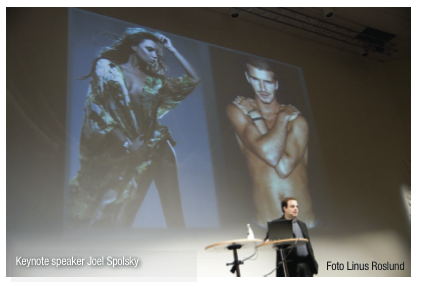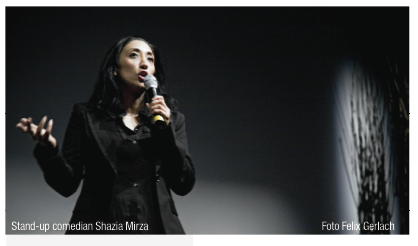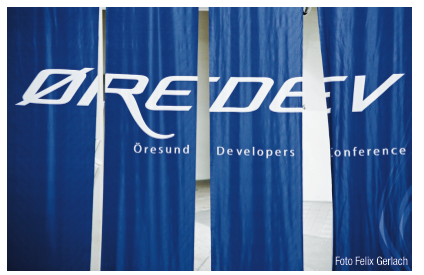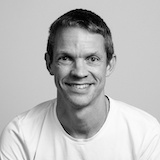Øredev 2007
co-authors: Jakob Klamra and Stefan Li
As most of you know Jayway is one of the organizers of Øredev. Knowing that, and knowing how much we love our own conference, you might not trust our judgment in this review. We beg to differ, and ensure you that Øredev is just as enjoyable as we describe it in this article.
The Conference
During the last three years, Øredev has grown from a promising initiative to one of the biggest IT-conferences in Scandinavia. During this year’s event, over 800 visitors attended more than 100 events. To handle the increasing crowd, the conference was held at a new location, MalmöMässan, which offered bigger and better conference halls and more space for the show floor. The location also offered a lack of heating in some rooms, which in the Swedish November weather translates into cold conference halls. People kept chugging coffee to keep warm, and everybody wished Oracle would hand out blankets instead of bottle chillers. As many as nine parallel tracks were available this year. Back from last year were: Java, .NET, Methods & Tools, etc. In addition to these, Øredev 2007 offered several new tracks such as Architecture, Case Studies and more. Especially refreshing were the User Experience sessions, an important yet often overlooked topic. Further indicating the growing status of the conference was the number of notable speakers that participated this year. The list included big names such as Andy Hunt, Joel Spolsky, Kevlin Henney, James Coplien, Dan North, and Dr. Jeff Sutherland. At the exhibition floor 26 companies were fighting for the visitors attention. The innovation in terms of advertising varied ranging from plain old booths with posters and free pens to elaborate coding competitions with iPods to win. In spite of being an IT conference, there was only one robot on the show floor, the SMErobot from Lund. Completely implemented in Java the robot was solving sudoku and carving in wood taking it’s instructions from a piece of Anoto paper. As a request for new functionality we would like to see the robot performing massage. Should not be too hard to implement, considering that the platform is Java based.
Keynotes
Being a keynote speaker is always special. There are high expectations of both visions and entertainment. Being recognized in the business, you would better have a good presentation up your sleeve. Although some of this years speeches contained more wittiness than visions, there were three enjoyable keynotes to listen to.
Andy Hunt: How hard can it be?
Andy Hunt is well known as one of the 17 founders of the Agile Alliance and the co-founder of the Pragmatic bookshelf. During his opening keynote, Hunt asked the audience the infamous question “How hard can it be?”. He answered the question himself by stating that there are two different types of complexity, namely essential complexity and accidental complexity. Essential complexity is the complexity required to do a job. It is something that we all have to live with, some things are hard to achieve by nature. Accidental complexity or unnecessary complexity on the other hand is something that is artificial. It should and can be prevented if it is recognized accordingly. There are many possible reasons for accidental complexity; prejudices or ignorance, stress or lack of motivation or even just bad luck. Regardless reason, the recipe to avoid accidental complexity is always the same: rely on reliable things, make a purposeful plan and stick to it.
Dan North: No Best Practices: Methodology for thinkers
Dan North is a renowned speaker from other conferences like JAOO, Agile and OOPSLA in topics like learning theory and behaviour-driven design. The keynote North gave at Øredev showed he has a rightful reputation. As the title indicates, the main mantra in North’s presentation was that there is no such thing as best practices. As he presented this theory the feeling was similar to the scene in Dead Poet’s Society where the teacher asks his students to rip out the first chapter of their text books. As a basis for his claim, North explained the Dreyfus Model of Skill Acquisition. The Dreyfus Model is in itself an interesting topic and describes five different stages in learning: Novice, Advanced Beginner, Competent, Proficient and Expert. The novice is the stage of an absolute beginner who relies on rules and guidance to be able to function whereas the Expert works based off intuition and knowledge at the subconscious level that has been gathered through many years of work. The interesting part is that the efficiency of people at the expert level is severely reduced if they are bounded by the safe environments such as a “best practice” that the novice needs. Best practices are in other words obstructing the people who are the best, the experts, from doing their job effectively. 
Joel Spolsky: Developing Great Software
Joel Spolsky has reached his biggest audience through his website joelonsoftware. com. He is the founder of Fog Creek Software and has created FogBugz, a popular project management system. Ten seconds into his seminar, Spolsky immediately showed that he belongs to the rare selection of people that knows how to make a powerpoint presentation that is more than just a bunch of slides. As Spolsky brought up a huge picture of Victoria Beckham on the first page, you knew that you were in for a treat. The topic of the speech was the importance of good looking software. Spolsky argued that no matter how good your software is, you will not reach mass market unless it looks good. He illustrated this through various comparisons of popular products. Particularly entertaining was the part where he brought up a Windows XP simulation created entirely within the powerpoint presentation. One could argue whether that was a good example to bring up in the context of his speech. Windows is a product that doesn’t necessarily look good compared to one of its main competitors (OS X), yet has a vastly larger market share. Nevertheless, the display was impressive and produced lots of laughs from the audience as Spolsky struggled with various pop-ups and failures in his powerpoint-driven “Windows”. Even though his presentation clearly was more about entertainment than anything else, he managed to state an important point: software needs to look good to succeed! 
Sharing Knowledge
Besides the keynotes the real knowledge sharing was made in the around 80 sem nars and in the exhibition hall. Following the Java track we witnessed the official launch of the Qi4J framework, introducing Composite Oriented programming, redefining the way we use OOP today. The new concepts that Qi4J bring are not obvious, even to somebody with extensive Java experience. We are hoping that Qi4J for dummies will turn up in our local book store soon. We also got a first glimpse of Java FX Script, the new GUI framework from SUN. It has been developed to provide an alternative to the clunky looking Swing interfaces. Although not yet mature, it is meant to compete with technologies like Flash and Silverlight. Another interesting seminar was delivered by Neo Technology, showing us a new and faster way to store data. Briefly, they have implemented a database using a netbase, i.e. networks in Java rather than database tables. During the presentation, they performed a simulated Facebook relation search outclassing a traditional database by the magnitude of a million. Identifying some of the trends using Java as a platform rather than as a language is becoming big. More lightweight languages and scripts such as JRuby on Rails make use of the Java platform. Domain Driven Design and Web 2.0 (still) were other buzzwords that floated around in the lecture halls. As always at Øredev there was a big focus on open source. The business is changing more towards using and developing open source frameworks incorporating community thinking into their development process. There were several seminars that both presented new functionality within existing frameworks and showed smart ways of using existing technologies. One example was the demonstration of the new batch framework in Spring. Sitting in on some of the test and project management seminars a couple of keywords emerged over and over again, namely “agile” and “test driven”. Even though most people know that these methods increase productivity and quality of the code, a quick audience survey showed that there are still few development teams that actually have incorporated these into their processes. Apparently, it is still tricky to convince your boss that agile development actually does bring huge winnings.
Evening activities
After a full day of new knowledge, inspiring lectures and networking the stage was taken by the UK stand-up comedian Shazia Mirza. Mirza is a highly acclaimed comedian and a columnist for the New Statesman. She was recently profiled on CBS ‘60 minutes and has performed all over Europe and USA. Mirza put on a great show not being the least shy or politically correct, even though she was, as she put it, “the only Asian woman amongst 600 computer nerds”. Some great laughs later it was back to business with late evening “Birds Of Feathers” (BOFs), making full flown eagles out of the feathers of knowledge we had been given during the conference. Some of us joined Owen Taylor at Gigaspaces, making a complete Gigaspace storage run on our laptops. We were given a chance to try out this new technology together with one of it’s creators, enabling us to bring the installation back home for further experiments and tests. We got (and still have) a good possibility to look under the hood of the magic this product brings, at least that is promised by Taylor. For the people that had enough of birds and feathers there was more entertainment from our own band Rockway. 
Workshops
There were many that sought a hands-on experience with the material that was presented during Øredev, and all participants were given a chance to follow up the lectures with a variety of workshops. The most popular one was the full Scrum certification course held by Dr Jeff Sutherland, one of the main creators and preachers of the Scrum methodology. Another popular workshop was a full day of Qi4J training allowing programmers to try out the newly launched framework. Andy Hunt also followed up his lecture on refactoring wetware, i.e. the human mind, with a three hour workshops, allowing the participants to try out some of the concepts that will increase productivity and make more efficient use of our brain cells. Hunt presented a bunch of mind tricks that would have come very handy earlier in the conference.
Finally
The yearly Øredev conference is a source of inspiration to an increasing amount of people. As an employee in the IT sector it is a great opportunity to get access to all the knowledge presented at the conference, get hands-on with new technologies and share the visions of some of the biggest names in the business. We tend to spend more and more time behind our screens, teaching ourselves new tools, technologies and reinventing the wheel. With Øredev there is a possibility to meet like-minded people, share experiences and last but not least, to network. Adding new contacts on your favorite social website is an important goal as any. Besides the large amount of participants attending there is an increasing number of exhibitors from all over the world. Be sure to sign up for next year, because the conference will keep on growing, not only in the number of participants, but also in importance. There is no better way to keep up to speed with the ever changing market. Hopefully, the heat will be switched on in all seminar rooms by then. Until next Øredev… 
Originally published in JayView
